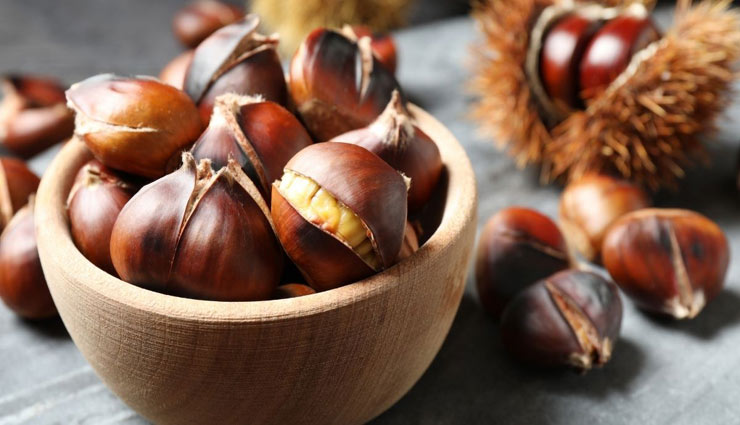Chestnut is both a fruit and a nut! Chestnut has a mild taste and is an excellent addition to various foods. Chestnut season is winter; eating roasted chestnuts by the fireplace is a double pleasure when the weather gets cold, and it snows. You will read everything you need to know about chestnuts in this article. Stay with us.
Properties of chestnut
1. Improves digestion
According to research, the chestnut extract has a protective effect on probiotics in the digestive system. Probiotics are beneficial bacteria that keep the gut healthy and improve the digestive process.
In addition, chestnuts have a lot of fiber. Fiber reduces constipation, promotes long-lasting satiety, stabilizes blood sugar, and promotes beneficial gut bacteria.
2. It contains antioxidants
In addition to being a good source of vitamins and minerals, chestnuts have many antioxidants, including tannins, alkaloids, lutein, ellagic acid, and gallic acid.
According to the research conducted by the Department of Biotechnology of Chosan University in Korea in 2010, chestnut flower extract has strong antioxidant properties. It even protects the body against damage caused by melanoma. Antioxidants are substances that neutralize harmful free radicals. These free radicals cause damage to cells as well as chronic diseases.
According to research, some antioxidants in chestnuts, such as ellagic acid, reduce the risk of diabetes by regulating blood sugar and increasing insulin balance.
Many whole foods, fruits, and vegetables contain antioxidants. Eating foods rich in antioxidants, such as chestnuts, may prevent many diseases.
3. It protects the heart
Certain types of chestnut have a protective effect on the heart. This protective effect is due to antioxidants that reduce inflammation and improve heart health.
In addition, chestnuts contain potassium. This vital mineral reduces some underlying factors of heart disease. According to research, increasing potassium intake lowers blood pressure and even reduces the risk of stroke by 24%. If you have heart problems, include chestnuts in your diet.
4. Strengthens bones
Only ten chestnuts contain 50% of the body’s daily manganese requirement. This mineral is essential for the normal functioning of cells. According to some research, manganese may also play a vital role in bone health and protect the body against diseases. According to a study, approximately 43% of manganese is stored in bones. Taking this nutrient with other bone-building minerals prevents bone loss, especially in older women.
Including chestnuts in your diet and other bone-strengthening nutrients keeps your bones strong and prevents osteoporosis.
5. Improves brain function
Chestnut contains several B vitamins, including thiamin, vitamin B6, riboflavin, and folate. These vitamins are essential to maintain brain health and protect against diseases. A deficiency of any of these B vitamins causes cognitive problems. For example, thiamine deficiency may lead to delirium, and folate deficiency impairs brain development in children.
In a 2016 study, elderly participants took folic acid for one year. Folic acid improves cognitive function while reducing some markers of inflammation.
According to another study published in the journal “Nutrition,” increased consumption of vitamin B is associated with improved cognitive performance in elderly participants with mild cognitive impairment and Alzheimer’s disease.
To ensure you meet your B vitamin needs and improve brain health, eat protein-rich foods and include chestnuts in your daily diet.
Nutritional value of chestnuts

The nutritional value of 10 roasted chestnuts (about 84 grams) is:
- Calories: 206
- Carbohydrates: 44.5 grams
- Protein: 2.7 grams
- Fat: 1.8 grams
- Fiber: 4.3 grams
- Manganese: 1 mg (50% of daily requirement)
- Vitamin C: 21.8 mg (36% of daily requirement)
- Vitamin B6: 0.4 mg (21% of daily requirement)
- Copper: 0.4 mg (21% of daily requirement)
- Folate: 58.8 micrograms (15% of daily requirement)
- Thiamine: 0.2 mg (14% of daily requirement)
- Potassium: 497 mg (14% of daily requirement)
- Riboflavin: 0.1 mg (9% of daily requirement)
- Phosphorus: 89.9 mg (9% of daily requirement)
- Vitamin K: 6.6 micrograms (8% of daily requirement)
- Magnesium: 27.7 mg (7% of daily requirement)
- Niacin: 1.1 mg (6% of daily requirement)
- Vitamin B5 or pantothenic acid: 0.5 mg (5% of daily requirement)
- Iron: 0.8 mg (4% of daily requirement)
- Zinc: 0.5 mg (3% of daily requirement)
How to eat chestnuts?
Raw chestnuts have a substantial and crunchy texture and become softer after cooking or roasting, which is a sweet and tasty snack. Chestnuts must be cooked before consumption. Cooking removes its skin and reduces its tannic acid content; Tannic acid is a plant compound with many adverse health effects.
- Take fresh chestnuts and make a small X-shaped cut on each with a knife. This small cut prevents the steam from escaping and the clichés from bursting in the oven.
- Place the chestnuts on the baking sheet and roast for 20 to 30 minutes at 218 degrees Celsius.
- When the skins of the chestnuts open and turn golden, it means the chestnuts are cooked.
- Remove them from the oven and let them cool for a few minutes.
- While they are still warm, peel them and drink them.
In addition, you can add cooked chestnuts to desserts, stews, and any other favorite food and enjoy its pleasant taste.
Made from ground chestnuts, chestnut flour is a gluten-free flour that you can use to make bread and pancakes.
Risks and side effects
Chestnut allergies are not as common as allergies to other types of nuts, such as peanuts, but they can sometimes cause severe symptoms. If you are allergic to tree nuts, it is better not to eat chestnuts.
A chestnut allergy may cause itching, swelling, wheezing, and redness. If you experience these symptoms after eating chestnuts, you should stop using them and see a doctor immediately.
While chestnuts are an excellent source of many essential nutrients, they are also high in carbohydrates. If you have diabetes or high blood sugar, use chestnuts cautiously. Of course, chestnuts belong to the group of complex carbohydrates, which means they are digested more slowly than other carbohydrates and are part of a healthy diet. However, it is better to keep the consumption balanced and combine it with other low-carb options to avoid blood sugar spikes.
I have frequently asked questions about chestnuts.
– What is the difference between oak and chestnut?
Oak is the fruit of the oak tree, and chestnut is the fruit of the chestnut tree. Oak is smaller and lighter in color than chestnut. Chestnuts have a sweeter flavor when ripe and roasted, while acorns contain tannins that give them a bitter taste.
– How to plant chestnuts?
To plant chestnuts, make a deep hole in the ground and put the seed inside. Then cover the source well with soil and fertilizer and water it. Additionally, you can propagate the chestnut tree by cuttings or grafting.
– How much is the price of chestnuts per kilo?
The price of chestnut depends on many factors, including the region and its type. Indian chestnut is one of its most popular varieties. Visit reputable stores to buy chestnuts.
you say
In this article, you find out what chestnut is and its properties. Are you also a fan of this plant? What features do you use it to take advantage of? Please share your valuable comments and experiences with our dear users and us.
Warning! This article is only for educational purposes; to use it, it is necessary to consult a doctor or specialist.



